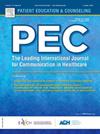Communicating therapeutic indication information in direct-to-consumer television ads for prescription cancer drugs: Exploring the effect of dual-modality presentations
IF 2.9
2区 医学
Q2 PUBLIC, ENVIRONMENTAL & OCCUPATIONAL HEALTH
引用次数: 0
Abstract
Objective
The rise in direct-to-consumer (DTC) ads for cancer drugs, which often have complex indications, raises concerns about consumer misunderstanding. A drug’s indication must clearly convey its condition(s) of use, which may include elements such as the approved patient population, second-line treatment status, and whether it is adjunctive or concomitant therapy. The study examines whether the modality used to communicate the drug’s indication in DTC television ads affects consumers’ recognition, recall, and comprehension.
Methods
We conducted two experimental studies testing dual-modality (voiceover and on-screen text) presentations of therapeutic indication information in television ads for non-small cell lung cancer (N = 281) and multiple myeloma (N = 287). In each study, the indication statement for all ads presented the medical condition in dual modality and varied the modality used to present additional elements of the indication (absent, audio-only, text-only, dual-modality). After viewing the ad twice, participants completed a questionnaire that measured indication recognition, recall, and comprehension.
Results
Dual-modality presentations led to improved communication outcomes relative to the control condition without unintended detrimental effects relative to single-modality presentations. Participants exposed to dual-modality presentations were more likely to correctly recognize the full indication statement and the drug’s intended use. The dual-modality presentation also improved recall and comprehension of the indication’s additional elements in one study, though not consistently across both. No consistent pattern emerged linking specific single modalities to better outcomes. In line with previous research, our results present nuanced outcomes, revealing the superior benefits of dual-modality presentations for some outcomes, but highlighting the influence of moderating factors.
Conclusions
Dual-modality presentations of indication statements may improve individuals’ recall, recognition, and comprehension of indication statements and facilitate better consumer understanding.
Practice Implications
These results support stakeholders continuing to investigate how indication statement complexity affects consumer understanding and expectations about drug eligibility.
在直接面向消费者的癌症处方药电视广告中传达治疗适应症信息:探索双模态呈现的效果。
目的:癌症药物的直接面向消费者(DTC)广告的增加,往往具有复杂的适应症,引起了对消费者误解的担忧。药物的适应症必须清楚地传达其使用条件,可能包括批准的患者人群、二线治疗状态以及是辅助治疗还是伴随治疗等因素。该研究考察了DTC电视广告中用于传达药物适应症的方式是否会影响消费者的认知、回忆和理解。方法:我们进行了两项实验研究,测试非小细胞肺癌(N = 281)和多发性骨髓瘤(N = 287)电视广告中治疗适应症信息的双模式(配音和屏幕文本)呈现。在每项研究中,所有广告的适应症说明都以双模态呈现医疗状况,并以不同的方式呈现其他适应症要素(无、纯音频、纯文本、双模态)。在看了两遍广告后,参与者完成了一份测量指示识别、回忆和理解的问卷。结果:相对于对照条件,双模态陈述导致了交流结果的改善,而相对于单模态陈述没有意想不到的有害影响。暴露于双模态演示的参与者更有可能正确识别完整的适应症声明和药物的预期用途。在一项研究中,双模态表现也提高了对适应症其他因素的回忆和理解,尽管在两种情况下并不一致。没有一致的模式将特定的单一模式与更好的结果联系起来。与之前的研究一致,我们的结果呈现出微妙的结果,揭示了双模态呈现对某些结果的优越性,但强调了调节因素的影响。结论:双重表述可以提高个体对适应症陈述的回忆、识别和理解,促进消费者更好地理解。实践意义:这些结果支持利益相关者继续调查适应症声明复杂性如何影响消费者对药物合格性的理解和期望。
本文章由计算机程序翻译,如有差异,请以英文原文为准。
求助全文
约1分钟内获得全文
求助全文
来源期刊

Patient Education and Counseling
医学-公共卫生、环境卫生与职业卫生
CiteScore
5.60
自引率
11.40%
发文量
384
审稿时长
46 days
期刊介绍:
Patient Education and Counseling is an interdisciplinary, international journal for patient education and health promotion researchers, managers and clinicians. The journal seeks to explore and elucidate the educational, counseling and communication models in health care. Its aim is to provide a forum for fundamental as well as applied research, and to promote the study of organizational issues involved with the delivery of patient education, counseling, health promotion services and training models in improving communication between providers and patients.
 求助内容:
求助内容: 应助结果提醒方式:
应助结果提醒方式:


